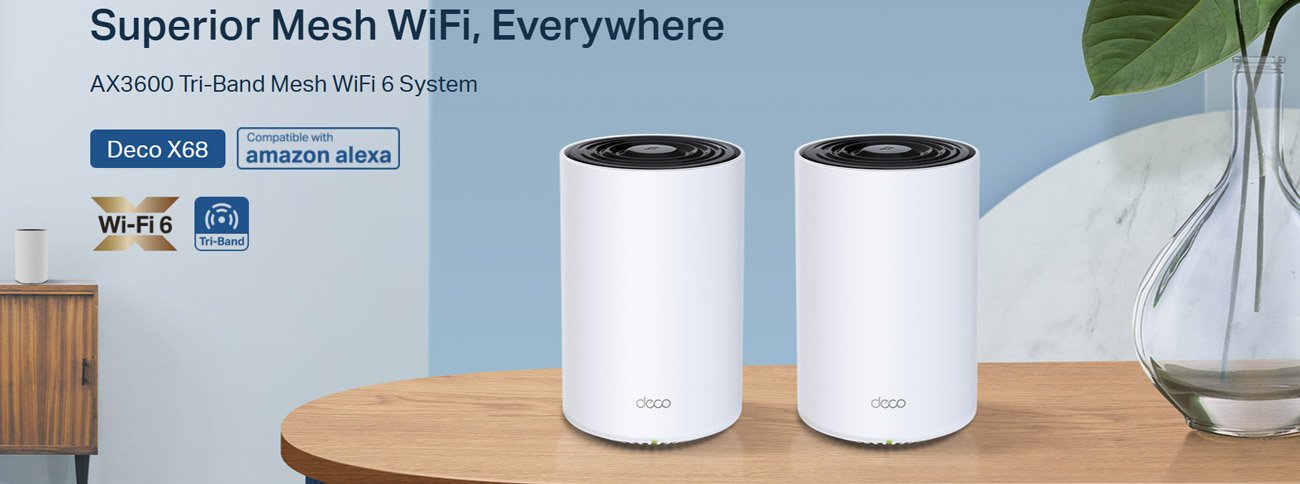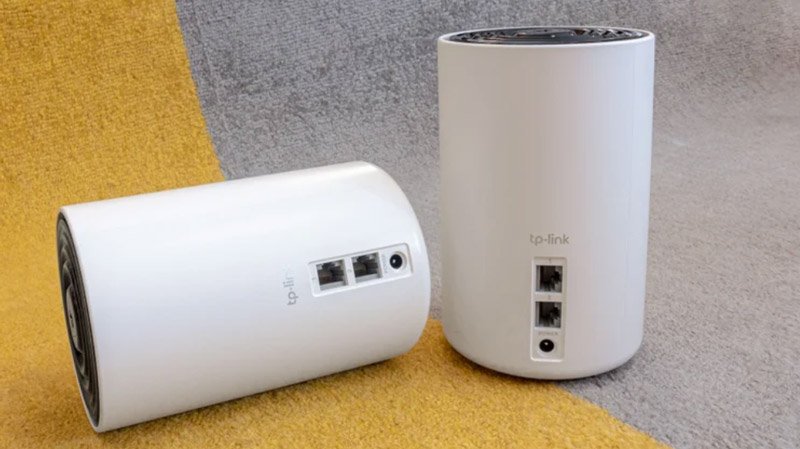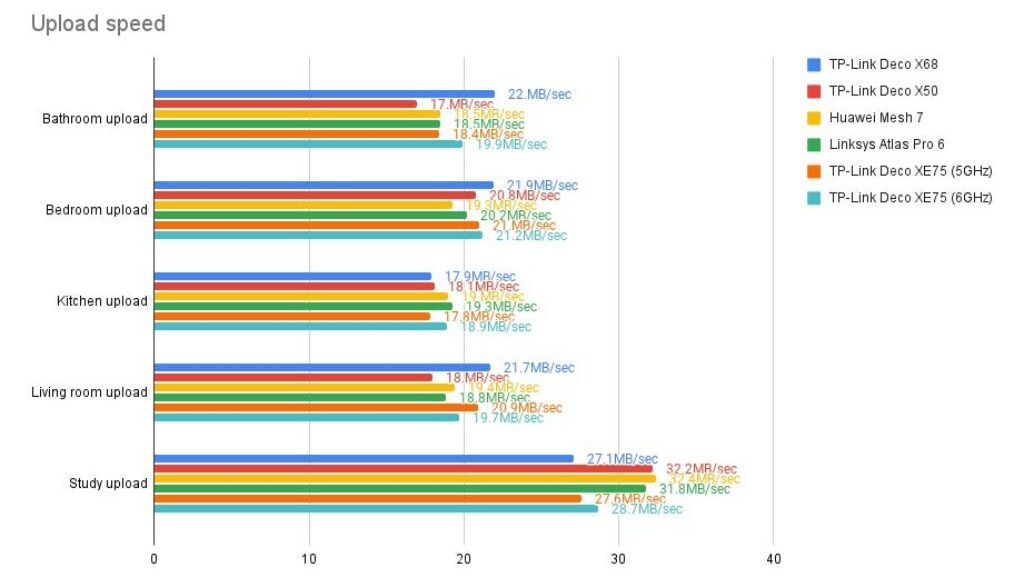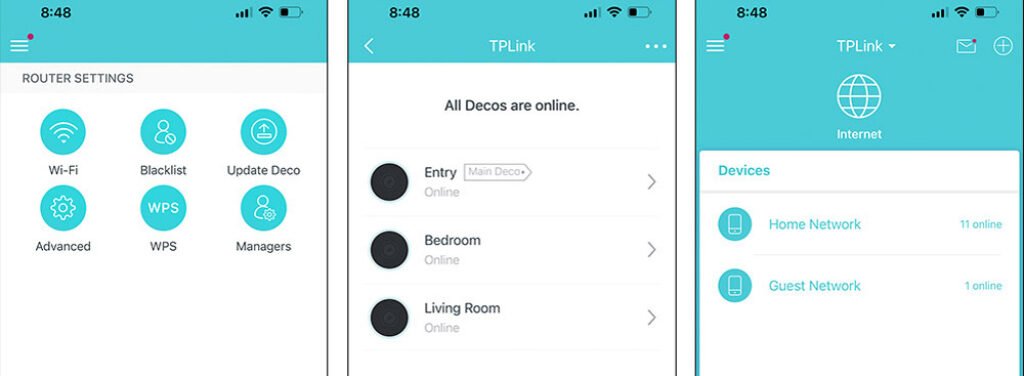TP-Link Deco X68 is reasonably priced, offers tri-band Wi-Fi 6 speeds up to a total of 3.6 Gbps. Two nodes can easily cover up to 5,500 square feet (approximately 527 square meters ), which is why it’s perfect for high-speed home-gigabit households.

TP-Link Deco X68 Pros and Cons
TP-Link Deco X68 Design
TP-Link Deco X68 has a somewhat modest design, with an elegant white look from its cylindrical body dimension 4.1 x 4.1 x 6.7 inches (105 x 105 x 169 millimeters), about the same size category as a smart speaker, so it convenient to place anywhere at home. Deco X68 has a glossy black top with concentric circle pattern, kind of like a speaker, and a coloured ring of LEDs around the light in the center which displays network status. On the back are a couple of gigabit Ethernet ports, with one being the uplink to a network modem.

Each Deco X68 device is equipped with a 1.5 GHz quad-core CPU and two Gigabit Ethernet ports on the back, which can be used as LAN or WAN. The main router always has one port taken up for the WAN connection to the internet source. You can also use the remaining ports as LAN to connect via a wired backhaul. This is great for homes where you think there may be a lot of interference, or hard to penetrate walls (concrete). Most mesh network systems don’t even give you an Ethernet port on every node, much less two. The base station only has a single port left over as one is needed to connect the device to the ISP’s modem/router. And if you want more wired connections, you can buy a basic network switch.
TP-Link Deco X68 Feature
- Tri-Band WiFi 6 Mesh WiFi: Next-gen WiFi 6 AX3600 whole home mesh system to eliminate weak WiFi for good. Perfect for 4K streaming, intense online gaming, and more throughout your whole home
- Seamless Coverage Boost — Get seamless coverage for your whole house up to 5500 sq. ft, with more stable and consistent whole home Wi-Fi 6 coverage
- Our Cybersecurity Commitment: TP-Link is a signatory of the U.S. Cybersecurity and Infrastructure Security Agency’s (CISA) Secure-by-Design pledge. This device is designed, built, and maintained, with advanced security as a core requirement.
- Connect up to 150 Devices: Revolutionary OFDMA and MU-MIMO technology lets your router communicate more data to more devices
- One Unified Network: Multiple units form a whole-home network that auto-selects the best connection as you move around your home
- AI-Driven Mesh: Intelligently learns the network environment to provide ideal WiFi unique to your home
- TP-Link HomeShield – TP-Link’s premium security service prevents cyber threats and protects your connected smart devices against malware. Free features: 1. Basic Network Security such as Security Scan and IoT Device Identification Basic Parental Controls 3. Quality of Service 4. Basic Weekly/Monthly Reports.
TP-Link Deco X68 Specifications
| Brand | TP-Link |
| Model Name | Deco X68(2-pack) |
| Special Feature | WPS |
| Frequency Band Class | Tri-Band |
| Standards and Protocols | Wi-Fi 6 IEEE 802.11ax/ac/n/a 5 GHz IEEE 802.11ax/n/b/g 2.4 GHz |
| WiFi Speeds | AX3600 5 GHz: 1802 Mbps (802.11ax) 5 GHz: 1201 Mbps (802.11ax) 2.4 GHz: 574 Mbps (802.11ax) |
| WiFi Range | 4-7+ Bedroom Houses (3-pack) |
| Guest Network | 1× 5 GHz Guest Network 1× 2.4 GHz Guest Network |
| Dimensions (W×D×H) | 4.1 × 4.1 × 6.7 in (105 × 105 × 168 mm) |
| Compatible Devices | Gaming Console, Security Camera, Personal Computer, Tablet, Smart Television, Printer, Smartphone |
| Included Components | 1 RJ45 Ethernet Cable, 2 Power Adapters, 2 x Deco X68 Units, 1 Quick Installation Guide |
TP-Link Deco X68 Performance
I tested the wireless rate of the TP-Link Deco X68 by connecting the host to my network modem in one corner of our study, and ensuring another node was installed at the opposite end in an adjacent bedroom. Next, I hooked up an Asus Drivestor 4 Pro NAS device to the Ethernet port of the host Deco and connected a test laptop—equipped with an Intel AX210 Wi-Fi card—to the 5GHz network. I then dragged the laptop around the house and got an average transfer rate for some file copies across to and from the NAS. Here’s what I found, plus results for a few competitors against which we tested.

The Deco X68 is well ahead of the cheaper Deco X50 and most of Huawei’s offerings in terms of performance. However, this doesn’t mean these mesh networks are useless: they prove to be fast enough to handle video streaming, Zoom calls, and other demands in every room. But that extra bandwidth offered by the Deco X68 could help more devices hit those maximum speeds at once and would allow faster data can be sent back and forth within your network. The Deco X68 also outperforms the Linksys Atlas Pro 6. Its short-range performance is actually slightly better and it’s £59 cheaper.

However, TP-Link Deco X68 falls short when compared to the Deco XE75, which supports 6E. Yes, under a 5GHz Wi-Fi 6 connection, the Deco X68 is slightly faster overall than the Deco XE75, but it lags slightly in same-room speeds. However, this difference is not noticeable in everyday use. When I enabled Wi-Fi 6E on the test laptop, the Deco XE75’s support for 6GHz gave it an edge over the Deco X68. If this seems like an unfair comparison, that’s precisely the point: any device connecting to your network in the future may support Wi-Fi 6E, but the Deco X68 won’t be able to fully realise its performance potential.
TP-Link Deco X68 Setup
Setup for the Deco X68 is mainly through a mobile app (also available on the Apple App Store and Google Play Store), just like other TP-Link Deco routers. This app is sleek, easy to use and takes users through the setup process in just 10 minutes. They can select either the 5GHz or 2.4GHz wireless bands: 5GHz offers faster transfer speeds but doesn’t penetrate walls as well as the 2.4GHz band. You can also allow the system to choose the coverage while creating visitor guests networks. This is a huge boon, a couple years ago setting up Wi-Fi was absolute madness compared to how trivially easy it is now.

After completing its setup the real challenge is how and where each node should be placed. To achieve optimal performance, they should not be placed on the floor or in corners and should not be obstructed by furniture. The key is to position them at a higher elevation so that the original network signal from the main node can be transmitted and connect to the additional nodes. For a four-room residence, selecting three nodes is the best choice for achieving maximum coverage based on the house layout and concrete walls, but it is important to note that each additional node will slightly reduce network speed.




 Amazon.com
Amazon.com 



